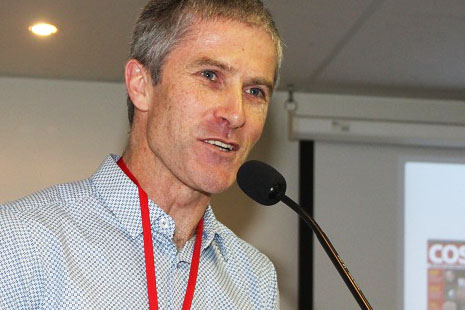ON A WET, miserable evening in Sydney not so long ago, a panel of academics came together to discuss the future of healthcare. As part of their preparation for the event, they and others had been asked to nominate their favourite metaphors for the challenges ahead. An assortment of powerful images was put forward – from boiling frogs to tsunamis to the doomed Titanic. A clear theme was a sense of hopelessness in the face of fragmented and dysfunctional systems, overwhelming demands and ever-escalating costs.
But a campaign recently launched in the United States suggests an alternative to these dismal pictures. It may well prove to be a landmark in efforts to steer healthcare onto a more sustainable footing by focusing on quality care and improved health rather than throughput. The campaign is significant because it is not the work of bean counters, but of a coalition of medical and consumer groups.
The first instalment of the Choosing Wisely campaign identifies forty-five tests and treatments that are often used even when they are unlikely to help patients, contributing to waste and potential harm. The American Board of Internal Medicine Foundation asked nine medical specialties each to produce a list of five tests and treatments that doctors and patients should question. Consumer Reports, the powerful consumer group and publisher, is producing plain English summaries for the public.
The lists, available at choosingwisely.org, include this recommendation from cardiologists: “Don’t perform annual stress cardiac imaging or advanced non-invasive imaging as part of routine follow-up in asymptomatic patients.” Why? Because the American College of Cardiology says this practice may “lead to unnecessary invasive procedures and excess radiation exposure without any proven impact on patients’ outcomes.”
In an article published in the Journal of the American Medical Association to coincide with the campaign’s launch at the National Press Club in Washington in April, two doctors from the foundation cite estimates that as much as 30 per cent of healthcare spending in the United States is wasted. The medical colleges involved in the Choosing Wisely campaign are, they say, “demonstrating leadership, vision, and courage in highlighting overuse in their own specialty.” Or, as one leading American medical academic puts it, the recommendations are coming “from the very groups that stand to benefit from doing more, not less.”
This is what makes the Choosing Wisely campaign so significant, according to H. Gilbert Welch, a professor of medicine at the Dartmouth Institute for Health Policy and Clinical Practice, who has been one of a relatively small band of researchers raising similar concerns for some time. “For years, medical organisations have been developing recommendations and guidelines focused on things doctors should do,” Welch wrote recently in the Los Angeles Times. “The specialty societies have been focused on protecting the financial interests of their most profligate members and have been reluctant to acknowledge the problem of overuse. Maybe they are now owning up to the problem.”
Welch says the campaign is also significant for making it clear that much of the problem of healthcare overuse arises from tests, which can be “the first step in a cascade of medical interventions.” Several more medical groups, including specialties in palliative care, rheumatology, geriatrics and pathology, are expected to join the campaign and release more lists of questionable tests and treatments later this year.
The Choosing Wisely campaign comes at a time when it seems there is no end to the list of reports highlighting the downside of too much healthcare. A new genre of medical books seems to be in the making, exploring over-investigation, overdiagnosis, overtreatment and overuse.
Welch is co-author of Overdiagnosed: Making People Sick in the Pursuit of Health, one of a growing number of books in this “over” genre. Another, soon to be launched, is Canadian researcher Alan Cassels’s Seeking Sickness: Medical Screening and the Misguided Hunt for Disease. And similar concerns are raised in a new book co-written by Otis Brawley, chief medical officer with the American Cancer Society, How We Do Harm: A Doctor Breaks Ranks about Being Sick in America, which focuses on overtreatment of the rich and undertreatment of the poor.
WHEN Brawley spoke at an Association of Health Care Journalists conference in Atlanta recently, his speech reportedly brought hundreds of applauding journalists to their feet. He encouraged the public to demand that doctors base their practice on science, and used the history of prostate cancer screening and bone marrow transplants as two examples of the problems. “Doctors tend to confuse what they believe with what they know,” he said. “We need the sceptical, educated consumer.” The benefits of medicine more broadly are often exaggerated, and the public needs to accept that “death is a part of life.”
Brawley also called for a greater focus on prevention, and said that at present doctors who do interventions and procedures get far more money than they should, in contrast to those involved in talking and counselling. The recommendations of the Choosing Wisely campaign would decrease doctors’ incomes “and that may be a good thing overall,” he said.
In May, Brawley engaged in a Twitter debate about the US Preventive Services Task Force’s statement that “there is moderate certainty that the benefits of PSA-based screening for prostate cancer do not outweigh the harms.” Brawley tweeted that too much of the discussion about prostate cancer screening had been about possible benefits rather than risks. Most of the side effects of screening are from overtreatment, “but it’s the test that starts the cascade,” he said.
After its conference, the Association of Health Care Journalists published an article giving journalists tips on how to investigate overdiagnosis and overtreatment, and particularly screening. But we also need to bear in mind the potential for the “less is more” push to have unintended consequences. These might include discouraging people from seeking healthcare of proven benefit, causing stigma for those with genuine conditions, stifling innovation, or encouraging a focus on the healthcare of the world’s wealthy.
Not surprisingly, the United States has been the engine room of the “over” argument. One reason, as was made clear at a recent conference in Massachusetts, Avoiding Avoidable Care, is that it has been spectacularly successful in showing how throwing more money at healthcare does not necessarily translate into better health.
The Institute of Medicine’s president, Harvey Fineberg, told the conference that the United States spends more per capita on healthcare than any other industrialised country, while lagging behind on health measures such as life expectancy and infant mortality..
While some medical leaders in Australia have downplayed the risks of overuse being an issue here, others say that it would be a mistake to assume that overdiagnosis and overtreatment are a peculiarly American problem. Indeed, Australian researchers and clinicians who attended a meeting on overdiagnosis at Coolangatta in April plan to promote a global focus on the issue. In an article published last week in the BMJ, they announced plans for an international scientific conference called Preventing Overdiagnosis, to be held in September next year in the United States. Bond University is one of the organisers, together with the Dartmouth Institute for Health Policy and Clinical Practice, the BMJ and leading US consumer organisation Consumer Reports. The BMJ also plans to run a series of articles on overdiagnosis in the lead up to the conference.
Many of the responsible forces that contribute to overdiagnosis and overtreatment are also at work in other countries, including Australia. These include health systems that are overly focused on hospitals and specialist medicine rather than primary healthcare, as well as legal pressures and ingrained cultural beliefs. Alongside these factors are powerful professional and commercial interests that promote medicalisation and constantly seek to expand the boundaries of diagnosis and treatment.
And we never know as much as we think we do. When a mammography screening program for breast cancer was set up in Australia in 1991, few would have predicted that it would result in the over-detection of cancers. In other words, it has identified some cancers that would not have caused harm if left undetected and untreated. It has been estimated that up to one-third of the cancers diagnosed via mammography screening may fit this category. The BMJ article noted that research on overdiagnosis is now recognised as part of the future scientific direction of the National Cancer Institute’s division of cancer prevention in the United States.
There are many other examples of the pace of technological development outstripping our ability to understand the health impact of new interventions. Overtreatment, one speaker told the Avoiding Avoidable Care conference, could be seen as “the illegitimate child of technology in an age of market medicine.”
Measures aimed at increasing community access to healthcare – by expanding the roles of health professionals, for instance – can also have unintended consequences. A new course for nurses in “point-of-care testing” at Flinders University illustrates the risks. The course brochure describes “a new and exciting discipline of clinical practice that is revolutionising the delivery of pathology services globally” by enabling a range of tests for diseases “to be performed on small instruments or devices outside the laboratory, in hospital and primary care settings… Now, and increasingly into the future, members of the nursing profession are the front-line operators of this new and innovative technology.”
What the brochure doesn’t mention are concerns that point-of-care testing may result in many more tests being done, with uncertain health returns for the investment involved.
The promotion of new tests and treatments of uncertain worth is often amplified by media coverage that fails to discuss uncertainties and potential harms adequately, according to Amanda Wilson, a researcher who runs Media Doctor Australia, an initiative analysing coverage of new medical drugs and treatments. This is likely to become even more of a concern as genetic tests become more widely promoted, she says. “We need to consider the regulation of marketing of tests. You wouldn’t be allowed to market drugs the way tests are marketed.”
As Gilbert Welch notes, many of the problems of overuse result not so much from “bad doctors” as from a “bad system” that tends to reward more care rather than appropriate care. According to a 2008 Canadian Health Services Research Foundation publication, Myth: In Healthcare More Is Always Better, the structural features that correspond with overuse include the kind of fee-for-service system that operates in Australia.
Tim Woodruff, vice-president of the Doctors Reform Society, has been a vocal critic of fee-for-service financing, arguing that overuse will not be tackled without team-based salaried models. He cites evidence from the highly regarded Mayo Clinic and the managed-care fund Kaiser Permanente in the United States that suggests this approach is good not only for the bottom line but also for patients’ care.
Carol Bennett, CEO of the Consumers Health Forum, agrees that such reforms are needed. “Ultimately we’d like a move away from fee-for-service because it encourages throughput,” she says. “We want to reward doctors for producing better health outcomes.”
Despite the political pain that such reform would involve – given the might of the private medical, dentistry and psychology lobbies, to name just a few of the interests involved – Bennett is confident it will be facilitated by the increasing collection of data measuring health service performance. “We are inevitably moving away from fee-for-service because it just isn’t sustainable,” she says.
While it is important to tackle overuse, Bennett expects that these reforms would be most likely to affect better-off Australians, who tend to have better access to healthcare. It is equally important, she argues, to ensure care is targeted towards those most in need.
ONE of the metaphors I took to the University of Sydney forum on that dreary evening back in April was the scales of justice, whose symbolism can be applied to the challenges confronting healthcare, including the imbalance between the world’s healthy and wealthy, and the rest. Then there is the imbalance within the system between public health and primary healthcare, on the one hand, and the very lucrative branches of medicine, on the other; between the population health perspective and the political clout of the medical-industrial lobby; and between the power of the most vulnerable and that of the powerful professional and industry organisations.
The forum’s speakers, who had expertise in redesigning health services and in a range of health disciplines, identified many challenges facing healthcare, including the need to tackle inefficiencies and break down funding, organisational and professional silos. The discussion also canvassed the potential of “co-production” (as one report described it, “the changing role of patients from passive recipients of health services to active partners and co-producers of their own health”) and the benefits that could flow from much greater involvement of patients and community members.
But in the end, the discussion came back to another reading of the scales of justice: the imbalance between our readiness to spend on healthcare and our readiness to take action in other areas that may do at least as much for improving the community’s health. As one speaker noted, urban design, transport availability, food supply and pollution are all profoundly health-related issues. Societal change would play a far more powerful role in improving the population’s health than anything the health system can achieve.
Similar issues concern Justin Coleman, a Brisbane GP with public health qualifications and a social justice bent, who is also president of the Australasian Medical Writers Association. In January Coleman launched the Naked Doctor column on a health blog I moderate, Croakey, with the aim of encouraging discussion and awareness of the opportunities to do more for health by doing less. It is an ever-expanding compilation of articles, books and other works that highlight overdiagnosis and overtreatment.
Coleman has been delighted by the reception, which has included invitations to give several Naked Doctor lectures, including to a Royal Australian College of GPs conference later this year. “I’ve had far more responses to this than anything else I’ve done in my writing career,” he says. “Virtually everyone I’ve discussed it with, whether medical or non-medical, whips out an anecdote and says, ‘This happened to me or my grandmother.’”
After a decade of working in Aboriginal health, Coleman says he has come to the view that more effort should be devoted to implementing proven interventions rather than constantly focusing on the latest new thing that often transpires to be of uncertain benefit. He also believes that the best way to improve the health of future generations is to spend more on education rather than healthcare, and he hopes that efforts such as his will encourage this wider focus. “One would hope that if you’re spending a bit less on MRIs and arthroscopies then there might be more in the budget for other things,” he says.
Balancing the scales of justice might mean not only that healthcare is directed at those most likely to benefit, but also that more resources and attention are paid to the factors beyond health services that influence health. •




